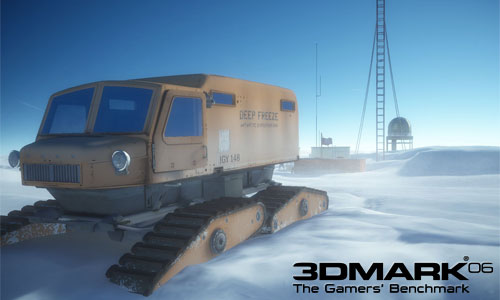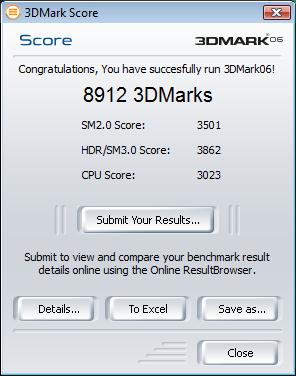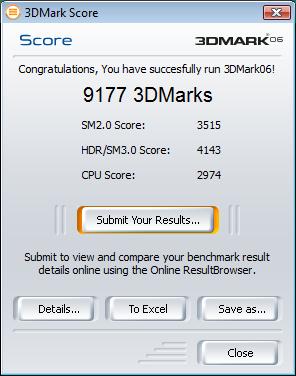|
PALIT Geforce 9600GSO Sonic

3D Mark 06

3DMark®06 is the worldwide standard in advanced 3D game performance benchmarking. A fundamental tool for every company in the PC industry as well as PC users and gamers, 3DMark06 uses advanced real-time 3D game workloads to measure PC performance using a suite of DirectX 9 3D graphics tests, CPU tests, and 3D feature tests. 3DMark06 tests include all new HDR/SM3.0 graphics tests, SM2.0 graphics tests, AI and physics driven single and multiple cores or processor CPU tests and a collection of comprehensive feature tests to reliably measure next generation gaming performance today.
 |
 |
The system with the GeForce 9600GSO was rated to have 8912 3DMarks with the standard settings before over clocking the GPU. With the assistance of the Vtune software, we were able to find a fast and stable setting at 750MHz Core, 100Mhz, Memory, and the shadier clock at 1700Mhz. With the GPU over clocked to these settings, the 3DMark score jumped to 9177 3DMarks. This was pretty cool considering it took all of two minutes to over clock the video card using the Vtune software.
| HDR (High Dynamic Range) |
High dynamic range rendering (HDRR or HDR Rendering), also known as high dynamic range lighting, is the rendering of 3D computer graphics scenes by using lighting calculations done in a larger dynamic range. Video games and computer generated movies benefit from this as it creates more realistic scenes than with the previous lighting model (referred to as "low dynamic range lighting" or "standard lighting"). Information from Wikipedia. |
| SM (Shader Modeling) |
The High Level Shading Language for DirectX implements a series of shader models. Using HLSL, you can create C-like programmable shaders for the Direct3D pipeline. Each shader model builds on the capabilites of the model before it, implementing more functionality with fewer restrictions. Shader model 1 started with DirectX 8 and included assembly level and C-like instructions. This model has many limitations caused by early programmable shader hardware. Shader model 2 and 3 greatly expanded on the number of instructions, and constants shaders could use. They are much more powerful than shader model 1, but still carry some of the existing limitations of the first shader model. Information from MSDN. |
Real Time Pricing:




